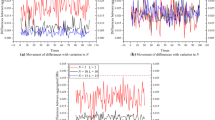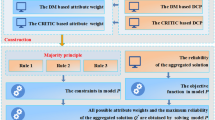Abstract
The weight and reliability of an individual assessment are two important concepts considered in the evidential reasoning (ER) approach. Through analyzing the existing studies on the combination of individual assessments with both their weights and reliabilities considered in the ER context, their deficiencies are identified in accordance with two principles. One principle is developed in the situation where a specific individual assessment is fully unreliable and the other is developed in the situation where all individual assessments are fully reliable. To address the deficiencies, this paper proposes a new method. In the method, a combination process that takes into account both the weights and reliabilities of individual assessments simultaneously is developed to generate the overall assessment. It is theoretically proven that the combination process satisfies the two principles. Three ways are designed to help a decision maker to flexibly provide individual assessments and determine their reliabilities. A strategic project evaluation problem for an enterprise located in Changzhou, Jiangsu, China is analyzed using the proposed method as a case study to demonstrate its validity and applicability. These are highlighted by its comparison with two existing methods.



Similar content being viewed by others

References
Baykasoğlu, A., Gölcük, İ, & Akyol, D. E. (2017). A fuzzy multiple-attribute decision making model to evaluate new product pricing strategies. Annals of Operations Research, 251, 205–242.
Bilbao-Terol, A., Arenas-Parra, M., Cañal-Fernández, V., & Bilbao-Terol, C. (2016). Multi-criteria decision making for choosing socially responsible investment within a behavioral portfolio theory framework: A new way of investing into a crisis environment. Annals of Operations Research, 247, 549–580.
Butler, J. C., Jia, J. M., & Dyer, J. (1997). Simulation techniques for the sensitivity analysis of multi-criteria decision models. European Journal of Operational Research, 103(3), 531–546.
Butler, J. C., Morrice, D. J., & Mullarkey, P. W. (2001). A multiple attribute utility theory approach to ranking and selection. Management Science, 47(6), 800–816.
Corrente, S., Greco, S., & Słowiński, R. (2017). Handling imprecise evaluations in multiple criteria decision aiding and robust ordinal regression by n-point intervals. Fuzzy Optimization and Decision Making, 16, 127–157.
Denoeux, T., & Masson, M. H. (2012). Evidential reasoning in large partially ordered sets Application to multi-label classification, ensemble clustering and preference aggregation. Annals of Operations Research, 195, 135–161.
Fu, C., & Xu, D. L. (2016). Determining attribute weights to improve solution reliability and its application to selecting leading industries. Annals of Operations Research, 245, 401–426.
Fu, C., Xu, D. L., & Yang, S. L. (2016). Distributed preference relations for multiple attribute decision analysis. Journal of the Operational Research Society, 67, 457–473.
García-Cascales, M. S., Lamata, M. T., & Sánchez-Lozano, J. M. (2012). Evaluation of photovoltaic cells in a multi-criteria decision making process. Annals of Operations Research, 199, 373–391.
Girubha, J., Vinodh, S., & Kek, V. (2016). Application of interpretative structural modelling integrated multi criteria decision making methods for sustainable supplier selection. Journal of Modelling in Management, 11(2), 358–388.
Hafezalkotob, A., Hafezalkotob, A., Liao, H. C., & Herrera, F. (2019). An overview of MULTIMOORA for multi-criteria decision-making: Theory, developments, applications, and challenges. Information Fusion, 51, 145–177.
Jiang, Z. Z., Zhang, R. Y., Fan, Z. P., & Chen, X. H. (2015). A fuzzy matching model with Hurwicz criteria for one-shot multi-attribute exchanges in E-brokerage. Fuzzy Optimization and Decision Making, 14, 77–96.
Jiao, L. M., Pan, Q., Liang, Y., Feng, X. X., & Yang, F. (2016). Combining sources of evidence with reliability and importance for decision making. Central European Journal of Operations Research, 24(1), 87–106.
Kong, G. L., Jiang, L. L., Yin, X. F., Wang, T. B., Xu, D. L., Yang, J. B., & Hu, Y. H. (2018). Combining principal component analysis and the evidential reasoning approach for healthcare quality assessment. Annals of Operations Research, 271(2), 679–699.
Liao, H. C., Wu, X. L., Mi, X. M., & Herrera, F. (2020). An integrated method for cognitive complex multiple experts multiple criteria decision making based on ELECTRE III with weighted Borda rule. Omega, 93, 102052.
Longaray, A., Ensslinb, L., Ensslinc, S., Alvesd, G., Dutrab, A., & Munhoz, P. (2018). Using MCDA to evaluate the performance of the logistics process in public hospitals: The case of a Brazilian teaching hospital. International Transactions in Operational Research, 25, 133–156.
Ma, Z. Z., Zhu, J. J., & Chen, Y. (2020). A probabilistic linguistic group decision-making method from a reliability perspective based on evidential reasoning. IEEE Transactions on Systems, Man, and Cybernetics: Systems, 50(7), 2421–2435.
Ölçer, A. İ, & Odabaşi, A. Y. (2005). A new fuzzy multiple attributive group decision making methodology and its application to propulsion/manoeuvring system selection problem. European Journal of Operational Research, 166(1), 93–114.
Shafer, G. (1976). A mathematical theory of evidence. Princeton University Press.
Wang, A. S., Luo, Y., Tu, G. Y., & Liu, P. (2011). Quantitative evaluation of human-reliability based on fuzzy-clonal selection. IEEE Transactions on Reliability, 60(3), 517–527.
Wang, Q., & Fang, H. B. (2018). Reliability analysis of tunnels using an adaptive RBF and a first-order reliability method. Computers and Geotechnics, 98, 144–152.
Winston, W. (2011). Operations research: applications and algorithms. Tsinghua University Press.
Xu, D. L. (2012). An introduction and survey of the evidential reasoning approach for multiple criteria decision analysis. Annals of Operations Research, 195(1), 163–187.
Yang, J. B., Wang, Y. M., Xu, D. L., & Chin, K. S. (2006). The evidential reasoning approach for MADA under both probabilistic and fuzzy uncertainties. European Journal of Operational Research, 171(1), 309–343.
Yang, J. B., & Xu, D. L. (2002). On the evidential reasoning algorithm for multiple attribute decision analysis under uncertainty. IEEE Transactions on Systems Man and Cybernetics Part A-Systems and Humans, 32(3), 289–304.
Yang, J. B., & Xu, D. L. (2013). Evidential reasoning rule for evidence combination. Artificial Intelligence, 205, 1–29.
Acknowledgements
This research is supported by the National Natural Science Foundation of China (Grant Nos. 72171066, 72001063, 72101074, and 71571060).
Author information
Authors and Affiliations
Corresponding author
Additional information
Publisher's Note
Springer Nature remains neutral with regard to jurisdictional claims in published maps and institutional affiliations.
Appendix Proof of Theorem 1
Appendix Proof of Theorem 1
Without the loss of generality, suppose that ri,l = 0 and rj,l > 0 for j ≠ i. Under this assumption, it can be derived from Eqs. (22)–(24) that
and
This indicates that the individual assessment B(ei(al)) has no influence on the combination result of the first i-1 assessments and further on the overall assessment.
When there are multiple individual assessments with zero-valued reliabilities, it can be similarly known that these assessments contribute nothing to the overall assessment. As a result, the principle presented in Proposition 1 is satisfied by the combination presented in Definition 3.
To focus on the principle presented in Proposition 2, the process of iteratively combining individual assessments developed by Yang and Xu (2013) is presented.
Definition A.1
(Yang & Xu, 2013) Given the individual assessments B(ei(al)) (i = 1, …, L) and their weights wi, the combination result of the first i assessments is defined as.
where
and
Suppose that ri,l = 1 for i = 1, …, L. Then, it can be found that Eqs. (22)-(24) reduce to Eqs. (36)–(38). In this situation, the overall assessment generated using Definition 3 is the same as the one generated using Definition A.1.
In other situations, where the above assumption is not satisfied, one can find that the combination result derived from Definition 3 is different from the result derived from Definition A.1 through comparing Eqs. (22)–(24) with Eqs. (36)–(38).
As a whole, this theorem is verified. □
Rights and permissions
About this article
Cite this article
Fu, C., Xue, M. & Chang, W. Multiple criteria decision making with reliability of assessment. Ann Oper Res 312, 121–157 (2022). https://doi.org/10.1007/s10479-021-04249-z
Accepted:
Published:
Issue Date:
DOI: https://doi.org/10.1007/s10479-021-04249-z



